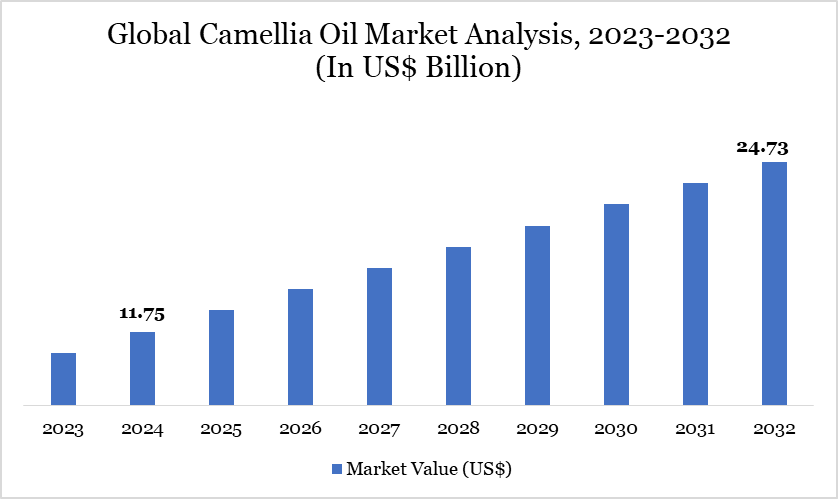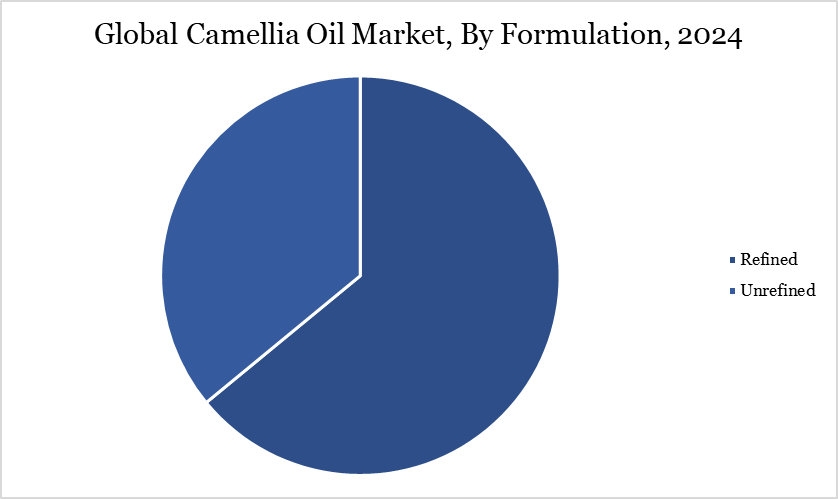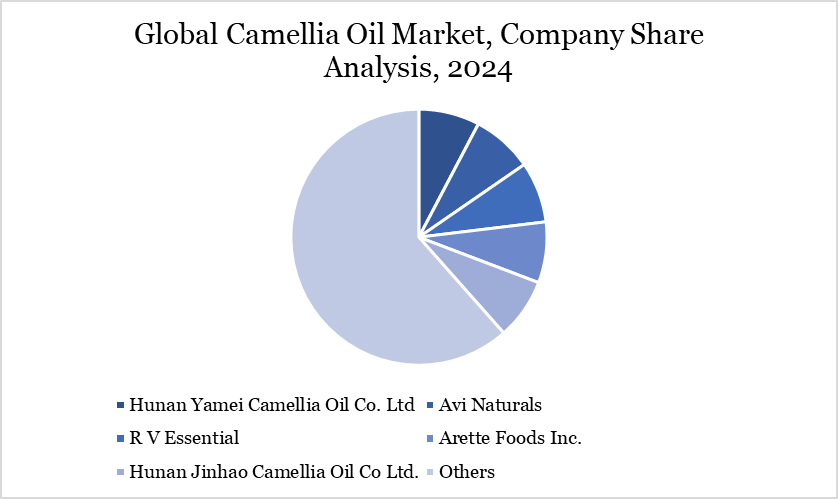Camellia Oil Market Size
Camellia Oil Market size reached US$ 11.75 billion in 2024 and is expected to reach US$ 24.73 billion by 2032, growing with a CAGR of 9.75% during the forecast period 2025-2032.
The camellia oil market is driven by its health benefits, including high antioxidants, vitamins and fatty acids, making it popular in skincare and haircare products. Additionally, its culinary uses enhance its appeal. Consumer shift toward sustainably sourced organic options, alongside the growth of e-commerce, increases accessibility and awareness of camellia oil products.
Recent advancements in extraction techniques for camellia oil, such as subcritical and supercritical extraction, have improved yield and quality, enhancing its market appeal. The discovery of bioactive compounds like oleic acid and polyphenols, known for their anti-tumor and anti-inflammatory properties, positions the oil as a valuable ingredient in cosmetics, pharmaceuticals and health foods.
Innovations and product launches expand the market reach to various end-users by launching products supported by clinical evidence and patents. Also, in December 2023, Shenzhen Winkey Technology launched WActive Camellia Squalane. This 100% plant-derived oil, extracted from Camellia seeds, provides deep hydration and supports skin barrier health without a greasy feel. It also enhances shine in hair care formulations. Approved by COSMOS and China, this product exemplifies eco-friendly innovation and the essence of oriental aesthetics.
Camellia Oil Market Trend
Rising demand in cosmetics, health foods, and pharmaceuticals is driving the market trend. China dominates production with over 95% of global output, while Japan leads in exports. Asia-Pacific holds the largest market share, followed by North America and Europe. India's camellia oil market is experiencing notable growth, particularly in exports.
Between October 2023 and September 2024, India exported 13 shipments of camellia products under HSN Code 3301, marking a 63% increase compared to the previous year. The primary importers were Poland, the Netherlands, and Sri Lanka, collectively accounting for 62% of these exports. India emerged as the leading global exporter in this category, surpassing countries like Japan and South Korea.
Domestically, India's edible oil production for the marketing year 2024/25 is projected at 9.1 million metric tons, slightly down from 9.3 million metric tons in the current year. This projection is based on an estimated availability of 35 million metric tons of oilseeds for processing. To meet the growing domestic demand and maintain price stability, the Indian government has extended lower import duties on edible oils until March 2025. This policy aims to balance the need for self-reliance with the practicalities of market demand and price control.

For more details on this report – Request for Sample
Market Scope
| Metrics | Details |
| By Product | Extra Virgin Camellia Oil, Pure Camellia Oil |
| By Type | Organic, Conventional |
| By Formulation | Refined, Unrefined |
| By Distribution Channel | Supermarkets, Specialty Stores, E-Commerce, Others |
| By Application | Food, Cosmetics, Pharmaceuticals, Chemical Industry, Others |
| By Region | North America, South America, Europe, Asia-Pacific and Middle East and Africa |
| Report Insights Covered | Competitive Landscape Analysis, Company Profile Analysis, Market Size, Share, Growth |
Camellia Oil Market Dynamics
Consumer Demand for Natural Products
Consumer demand for natural products is significantly driving the growth of the Camellia oil market, particularly in the beauty and personal care sectors. Health-conscious and environmentally aware consumers are increasingly favoring organic, sustainably sourced options that are free from synthetic additives. Camellia oil, known for its purity and beneficial properties, aligns with these values, making it a preferred choice for those seeking clean and natural alternatives.
In addition to its popularity in cosmetics, Camellia oil is gaining traction in the food industry due to its health benefits, including high monounsaturated fat content and antioxidant properties. These attributes make it an attractive alternative to traditional cooking oils for health-conscious consumers. The USDA's National Agricultural Statistics Service (NASS) has reported an increase in oilseed production, reflecting the growing demand for such health-oriented products. This dual application in both personal care and food sectors underscores the expanding market for Camellia oil in North America.
Competition from Other Oils
Competition from other oils, such as olive, coconut and argan oil, significantly constrains the camellia oil market. These alternatives are more widely recognized and accessible, dominating consumer preferences due to their established reputations and extensive marketing. Consequently, camellia oil’s unique benefits, like its antioxidant content and skin-nourishing properties, may be overlooked, limiting its market share.
Moreover, the versatility of competing oils, which serve multiple purposes in cooking and personal care, intensifies the challenge. Consumers often prefer familiar products that offer perceived value and convenience. People are unaware of the highlights of camellia oil’s advantages that make the camellia oil market struggle against these well-established alternative oils in the market.
Camellia Oil Market Segment Analysis
The global camellia oil market is segmented based on product, type, formulation, distribution channel, application and region.

Refined Formulation Segment Driving Camellia Oil Market
Refined Camellia oil demonstrates notable stability, making it suitable for various culinary applications. A study published in the journal Foods examined the effects of different refining degrees on Camellia oleifera oil during heating. The research found that refined oil exhibited a higher oxidation degree compared to crude and moderately refined oils; however, it maintained better stability during heating processes. This suggests that while refining can affect certain quality parameters, it also enhances the oil's suitability for high-temperature cooking applications.
In terms of versatility, Camellia oil's high oleic acid content, ranging from approximately 76% to 82%, contributes to its favorable nutritional profile and oxidative stability. This composition is comparable to that of olive oil, making Camellia oil a valuable alternative in both culinary and cosmetic industries. The oil's light texture and skin-friendly properties have led to its incorporation in various personal care products. Furthermore, its stability under heat and long shelf life enhances its appeal for diverse applications.
Camellia Oil Market Geographical Share
Demand for Camellia Oil in North America
In North America, the demand for Camellia oil is increasing, particularly in the cosmetics and personal care sectors. This growth is driven by consumer preferences for natural and organic ingredients, aligning with the broader clean beauty movement. Camellia oil's recognized benefits for skin and hair have made it a sought-after component in various beauty products.
Additionally, Camellia oil is gaining popularity in the food industry due to its health benefits, including high monounsaturated fat content and antioxidant properties. These attributes make it an attractive alternative to traditional cooking oils for health-conscious consumers. The USDA's National Agricultural Statistics Service (NASS) has reported an increase in oilseed production, reflecting the growing demand for such health-oriented products.
Sustainability Analysis
The Camellia oil market is increasingly aligning with sustainability principles, driven by both governmental initiatives and industry practices. In China, the largest producer of Camellia oleifera oil, the government has introduced policies encouraging farmers to adopt eco-friendly methods, leading to a rise in organic certification among producers.
Additionally, Japanese producers, such as those in Toshima, have implemented traceable production management systems and obtained Organic JAS and COSMOS certifications to ensure sustainable development of the Camellia Japonica industry. These efforts reflect a broader trend towards environmentally responsible cultivation and processing methods in the Camellia oil sector.
Camellia Oil Market Major Players
The major global players in the market include Hunan Yamei Camellia Oil Co., Ltd, Avi Naturals, R V Essential, Arette Foods Inc., Hunan Jinhao Camellia Oil Co Ltd., Aarnav Global Exports, Arian Enterprises, Oshima Tsubaki Seiyujo Co., Ltd, AG Organica and Aethon International LLP.

Key Developments
In February 2024, Herbal Essences introduced a new haircare range featuring pure plant-based ingredients like aloe and camellia oil. The products aim to provide nourished, yet lightweight hair care solutions. This launch emphasizes the brand’s continued commitment to natural, eco-conscious formulations.
In March 2023, Quzhou in Zhejiang Province launched a green and low-carbon industrial park project to promote sustainable development. The initiative focuses on fostering eco-friendly industries and energy efficiency. It aligns with China’s broader goals for carbon neutrality and green economic growth.
Why Choose DataM?
Data-Driven Insights: Dive into detailed analyses with granular insights such as pricing, market shares and value chain evaluations, enriched by interviews with industry leaders and disruptors.
Post-Purchase Support and Expert Analyst Consultations: As a valued client, gain direct access to our expert analysts for personalized advice and strategic guidance, tailored to your specific needs and challenges.
White Papers and Case Studies: Benefit quarterly from our in-depth studies related to your purchased titles, tailored to refine your operational and marketing strategies for maximum impact.
Annual Updates on Purchased Reports: As an existing customer, enjoy the privilege of annual updates to your reports, ensuring you stay abreast of the latest market insights and technological advancements. Terms and conditions apply.
Specialized Focus on Emerging Markets: DataM differentiates itself by delivering in-depth, specialized insights specifically for emerging markets, rather than offering generalized geographic overviews. This approach equips our clients with a nuanced understanding and actionable intelligence that are essential for navigating and succeeding in high-growth regions.
Value of DataM Reports: Our reports offer specialized insights tailored to the latest trends and specific business inquiries. This personalized approach provides a deeper, strategic perspective, ensuring you receive the precise information necessary to make informed decisions. These insights complement and go beyond what is typically available in generic databases.
Target Audience 2024
Manufacturers/ Buyers
Industry Investors/Investment Bankers
Research Professionals
Emerging Companies